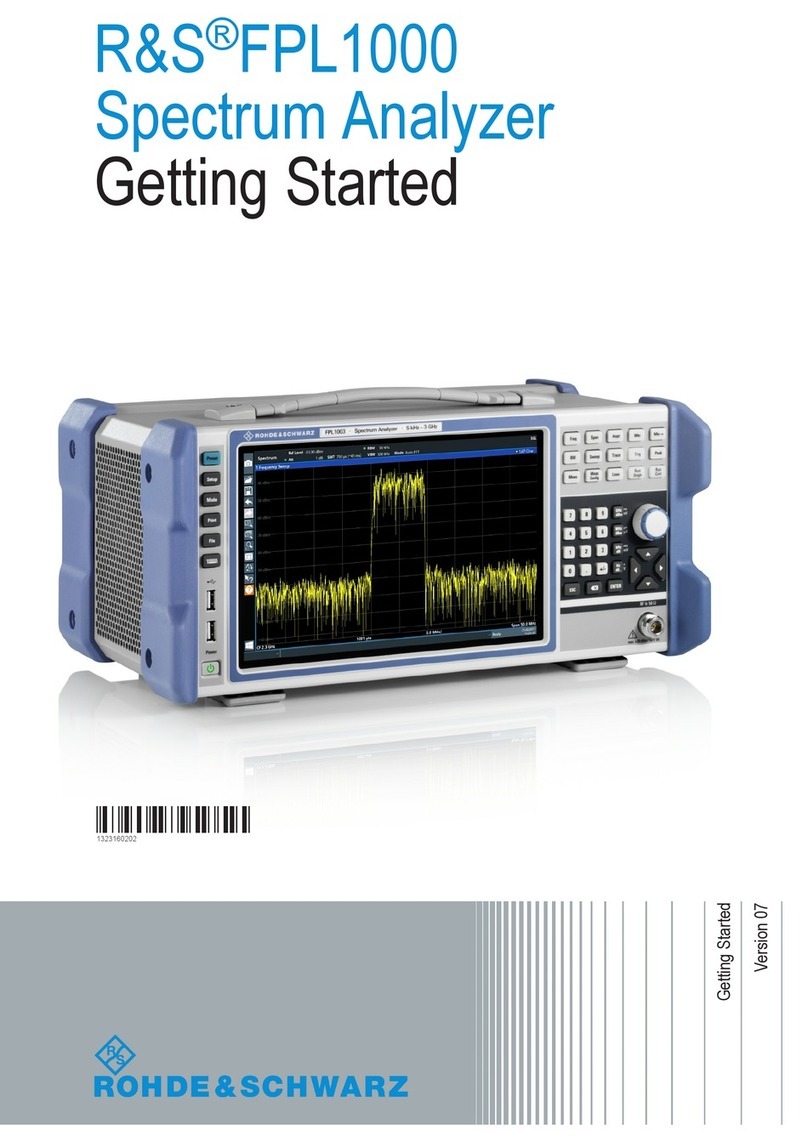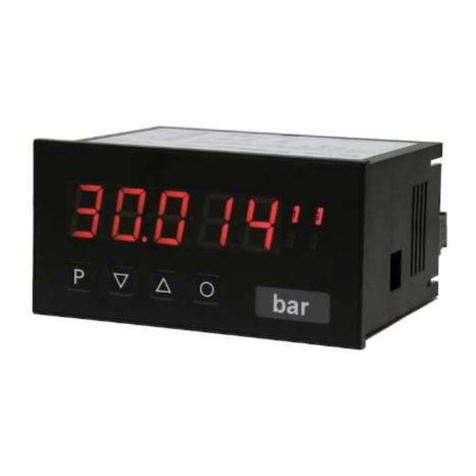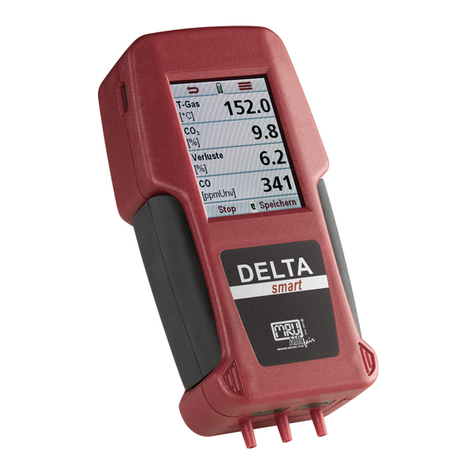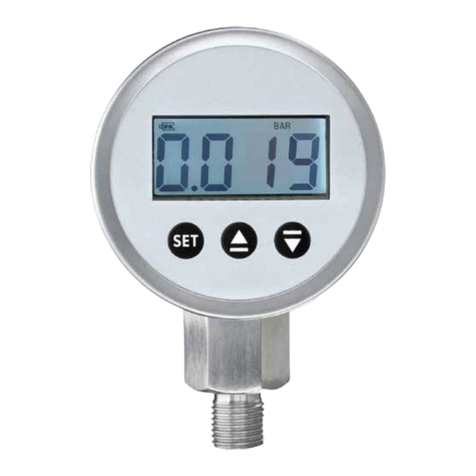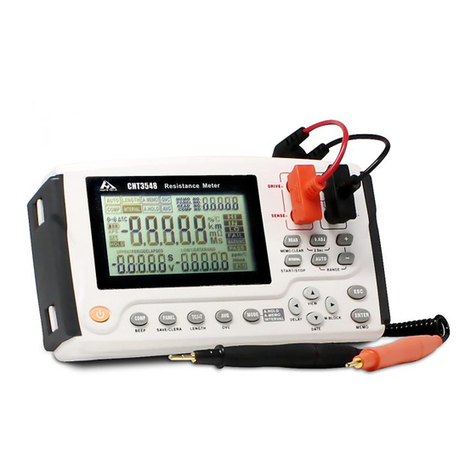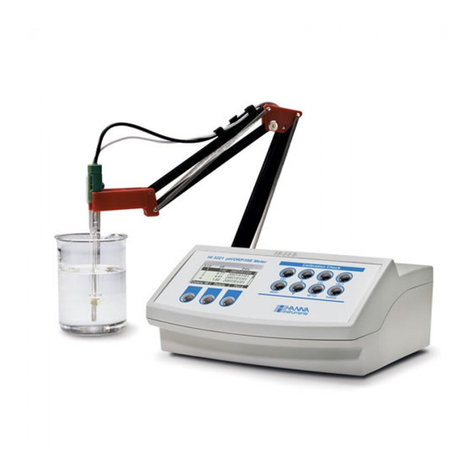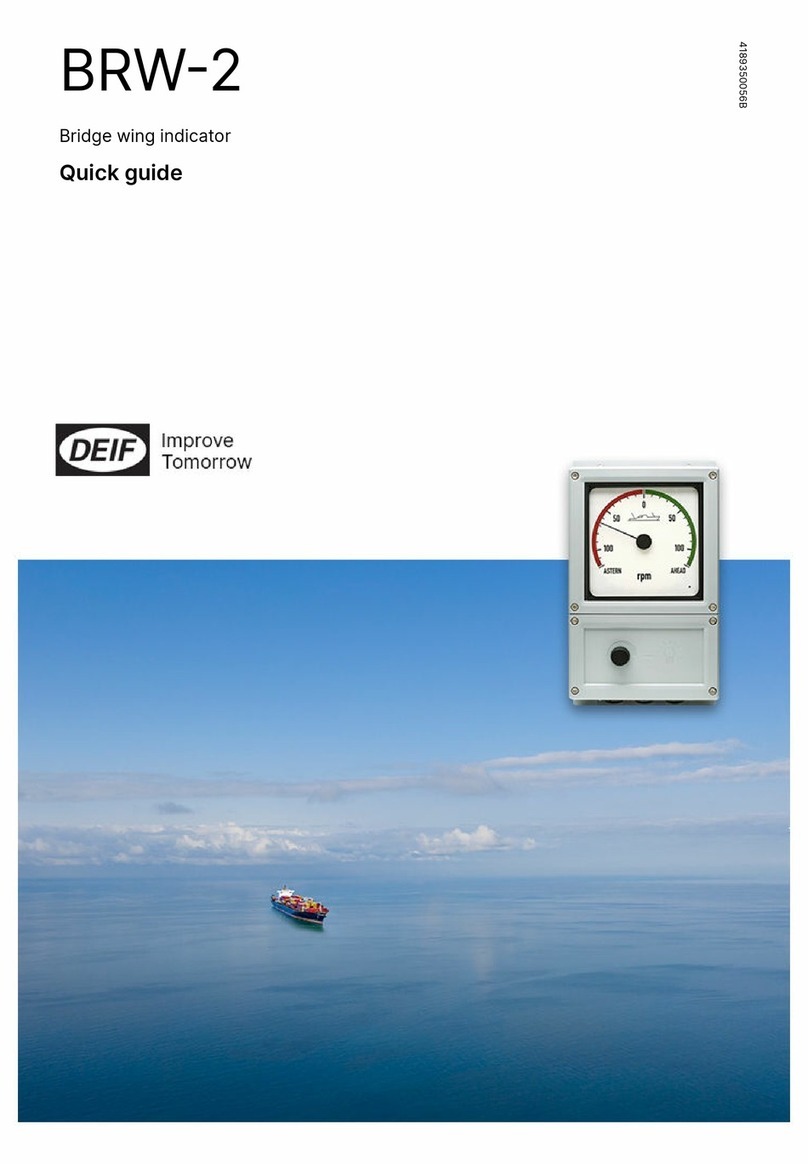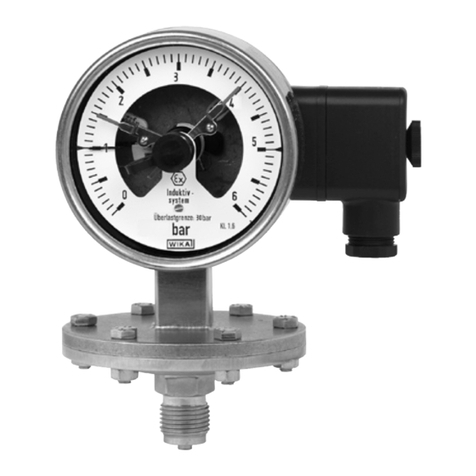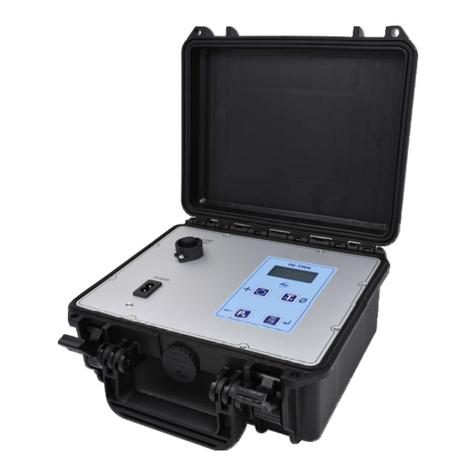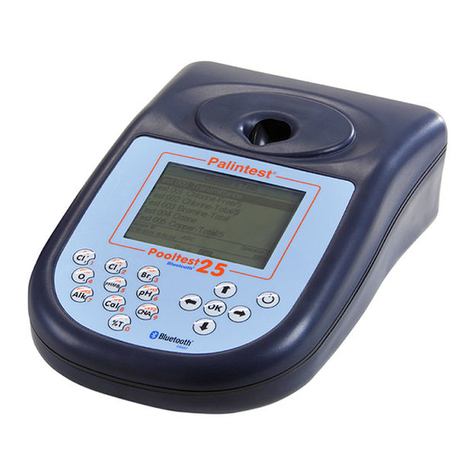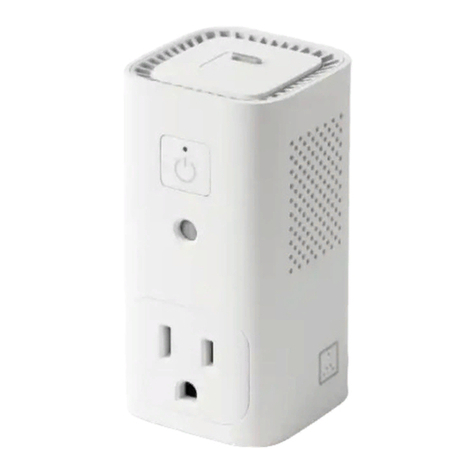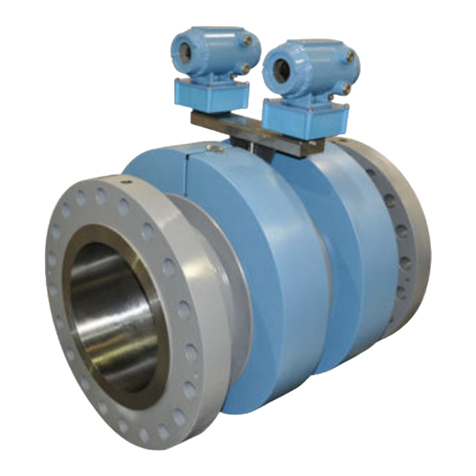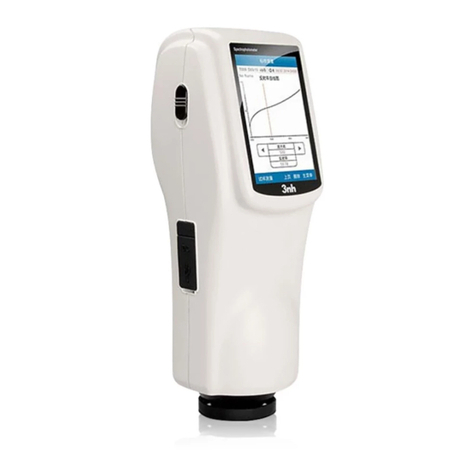Creative Sensor Technology DFM-6300 Series User manual

Creative Sensor Technology, Inc.
www.creativesensortechnology.com
PO Box 426, Rochester MA 02770 • Ph: 508-763-8100
RevDFM 0415
DFM-6300 SERIES Instruction Manual
KEY FEATURES
•NEMA 4X, IP65 Front
•Universal 85-265 VAC Input Power Models
•Large Dual-Line 6-Digit Display, 0.60" & 0.46"
•Isolated 24 VDC Transmitter Power Supply
•Programmable Displays & Function Keys
•Sunlight Readable Display Models
•Rate Displayed as Gallons per minute, Liters per second, Liters per minute
•Total displayed as Gallons, Cubic Meters, Cubic Feet
•Total, Grand Total or Non-Resettable Grand Total
•9-Digit Totalizer with Total Overflow Feature
•K-Factor Calibration
•Optional Outputs – Models DFM 6301: Two C Form Relays programmable
for rate or total + Isolated 4-20 mA Output to transmit rate
ORDERING INFORMATION
DFM-6300-00
Wall Mount flow monitor displays rate and total
DFM-6300-01
Panel mount flow monitor displays rate and total
DFM-6301-00
Wall mount flow monitor with Outputs 4-20mA + 2 relays
DFM-6301-01
Panel mount flow monitor with Outputs 4-20mA + 2 relays

DFM-6300 Series Instruction Manual
2
COMPLIANCE INFORMATION
Safety
UL & c-UL LISTED
USA & Canada
UL 508 Industrial Control Equipment
UL FILE NUMBER
E160849
FRONT PANEL
UL Type 4X, NEMA 4X, IP65; panel gasket provided
LOW VOLTAGE
DIRECTIVE
EN 61010-1:2010
Safety requirements for measurement, control, and
laboratory use
Electromagnetic Compatibility
EMISSIONS
EN 55022:2010
Class A ITE emissions requirements
Radiated
Emissions
Class A
AC Mains
Conducted
Emissions
Class A
IMMUNITY
EN 61326-1:2006
Measurement, control, and laboratory equipment
EN 61000-6-2:2005
EMC heavy industrial generic immunity standard
RFI - Amplitude
Modulated
80 -1000 MHz 10 V/m 80% AM (1 kHz)
1.4 - 2.0 GHz 3 V/m 80% AM (1 kHz)
2.0 - 2.7 GHz 1 V/m 80% AM (1 kHz)
Electrical Fast
Transients
±2kV AC mains, ±1kV other
Electrostatic
Discharge
±4kV contact, ±8kV air
RFI - Conducted
10V, 0.15-80 MHz, 1kHz 80% AM
AC Surge
±2kV Common, ±1kV Differential
Surge
1KV (CM)
Power-Frequency
Magnetic Field
3 A/m 70%V for 0.5 period
Voltage Dips
40%V for 5 & 50 periods
70%V for 25 periods
Voltage
Interruptions
<5%V for 250 periods

DFM-6300 Series Instruction Manual
3
Note:
Testing was conducted on DFM6300 meters installed through the covers of
grounded metal enclosures with cable shields grounded at the point of entry
representing installations designed to optimize EMC performance.
Declaration of Conformity available at www.creativesensortechnology.com
SAFETY INFORMATION
CAUTION: Read complete
instructions prior to installation
and operation of the meter.
WARNING:Risk of electric
shock or personal injury.
Warning!
Hazardous voltages exist within enclosure.
Installation and service should be performed only
by trained service personnel.
!

DFM-6300 Series Instruction Manual
4
INSTALLATION
There is no need to remove the meter from its case to complete the
installation, wiring, and setup of the meter for most applications.
Unpacking
Remove the meter from box. Inspect the packaging and contents for damage.
Report damages, if any, to the carrier.
If any part is missing or the meter malfunctions, please contact your supplier
or the factory for assistance.
Panel Mounting Instructions
•Prepare a standard 1/8 DIN panel cutout – 3.622" x 1.772" (92 mm x 45 mm). Refer to
Figure 1 for more details.
•Clearance: allow at least 6.0" (152 mm) behind the panel for wiring.
•Panel thickness: 0.04" - 0.25" (1.0 mm - 6.4 mm).
Recommended minimum panel thickness to maintain Type 4X
rating: 0.06" (1.5 mm) steel panel, 0.16" (4.1 mm) plastic panel.
•Remove the two mounting brackets provided with the meter (back-off the two screws so
that there is ¼" (6.4 mm) or less through the bracket. Slide the bracket toward the front of
the case and remove).
•Insert meter into the panel cutout.
•Install mounting brackets and tighten the screws against the panel. To achieve a proper
seal, tighten the mounting bracket screws evenly until meter is snug to the panel along
its short side. DO NOT OVER TIGHTEN, as the rear of the panel may be damaged.
Note: See Figure 10 on page 30 for 1/8 DIN Panel Cutout Template
Figure 1: 1/8 DIN Panel Cutout and Mounting
Panel
Gasket
Mounting
Bracket
Mounting
Screw
Removable
Connectors
3.622" (92 mm)
1.772"
(45mm)
Panel Cutout
to DIN 43700
Square Corners to 0.060"
(1.5mm) Max Radius
A
B
Tolerances:
A: +0.032 (+0.8mm)
-0.000 (-0.0mm)
B: +0.024 (+0.6mm)
-0.000 (-0.0mm)

DFM-6300 Series Instruction Manual
5
Mounting Dimensions
Figure 2: Meter Dimensions - Side View
Figure 3: Meter Dimensions - Top View

DFM-6300 Series Instruction Manual
6
Connectors Labeling
The connectors’ label, affixed to the meter, shows the location of all connectors
available with requested configuration.
Warning!
Do not connect any equipment to the RJ45 M-LINK
connector. This connector is intended for factory use
only. If non-standard equipment is connected to the
M-LINK, damage will occur to the equipment and the
meter.
Figure 4: Connector Labeling for Fully Loaded PD6300-CS
Wiring Connections
Power connections are made to a two-terminal connector labeled POWER on Figure
4. The + and - symbols are only a suggested wiring convention.
Figure 5: Wiring Connections

DFM-6300 Series Instruction Manual
7
Front Panel Buttons and Status LED Indicators
Button
Symbol
Description
LED
Status
Menu
1-8
Alarm 1 – 8 indicator
Right arrow/F1
R
Rate indicator
Up arrow/F2
T
Total indicator
Enter/F3
G T
Grand Total indicator
▲
Total overflow
indicator
M
Manual control relays
&/or analog output
•Press the Menu button to enter or exit the Programming Mode at any time.
•Press the Right arrow button to move to the next digit during digit
or decimal point programming.
•Press or hold the Up arrow button to scroll through the menus, decimal point,
or press or hold to increment the value of a digit.
•Press the Enter button to access a menu or to accept a setting.

DFM-6300 Series Instruction Manual
8
Display Functions and Messages
The meter displays various functions and messages during setup, programming,
and operation. The following table shows the main menu functions and messages
in the order they appear in the menu.
Display
Parameter
Action/Setting Description
DFM-6300 SERIES
Sensor
Sensor
Select the appropriate sensor
T10
T10
Type T10 Sensor
T15
T15
Type T15 Sensor
T20
T20
Type T20 Sensor
s-30
S-30
Type S-30 Sensor
s-40
S-40
Type S-40 Sensor
Cust
Custom
Custom Sensor
Factor
K-Factor
Custom Sensor K-Factor
Offset
Offset
Custom Sensor Offset
Rate Units
Rate Units
Select the display units for rate
Total Units
Total Units
Select the display units for total
OPTIONAL OUTPUT: DFM-6301 MODELS
Relay
Relay
Enter the Relay menu
Assign
Assignment
Assign relays to rate, total, grand total, or
Modbus
Asign1
Assign 1
Relay 1 assignment
rATE
Rate
Assign relay to rate
totAL
Total
Assign relay to total
G total
Grand total
Assign relay to grand total
RLY 1
Relay 1
Relay 1 setup
Act 1
Action 1
Set relay 1 action
Auto
Automatic
Set relay for automatic reset
A-nnm An
Auto-manual
Set relay for automatic & manual reset
any time
LatcH
Latching
Set relay for latching operation (relays
assigned to rate)

DFM-6300 Series Instruction Manual
9
Display
Parameter
Action/Setting Description
Lt-CLr
Latching-cleared
Set relay for latching operation with manual
reset only after alarm condition has cleared
(relays assigned to rate)
AltErn
Alternate
Set relay for alternation control (relays
assigned to rate)
SAnnm Pl
Sampling
Set relay for sampling operation
OFF
Off
Disable relay and front panel status LED
(Select Off to enable Interlock feature)
Set 1
Set 1
Program set point 1
RSt 1
Reset 1
Program reset point 1
RLY 2
Relay 2
Relay 2 setup
FaiLSF
Fail-safe
Enter Fail-safe menu
FLS 1
Fail-safe 1
Set relay 1 fail-safe operation
on
On
Enable fail-safe operation
off
Fail-safe off
Disable fail-safe operation
DeLAY
Delay
Enter relay Time Delay menu
DLY 1
Delay 1
Enter relay 1 time delay setup
On 1
On
Set relay 1 On time delay
OFF 1
Off
Set relay 1 Off time delay
Aout
Analog output
Enter the Analog output scaling menu
Dis 1
Display 1
Program display 1 value
Out 1
Output 1
Program output 1 value (e.g. 4.000 mA)
Dis 2
Display 2
Program display 2 value
Out 2
Output 2
Program output 2 value (e.g. 20.000 mA)
ALL DFM-6300 SERIES
PASS 1
Password
Password protect the meter
PASS t
Total Password
Password protect the resetting of the total

DFM-6300 Series Instruction Manual
10
Main Menu
The main menu consists of the most commonly used functions: Sensor, Rate
Units, Total Units, Relay, Analog Out, Password and Total Password.
•Press Menu button to enter Programming Mode then press the Up Arrow
button to scroll through the main menu.
52.0
876549
Sensor t10
Sensor
t15
sensor
t20
sensor
R
T
S-30
sensor
S-40
sensor
Cust
sensor
Factor
Cust
ddd.ddd
Factor
Offset
Cust
001.000
Factor
000.000
Offset
Go to
Rate Units
After Selecting
Sensor
Go to Rate Units
Pass 1
Pass t
Enter Password to
Lock Setup
Enter Password to
Lock Total Reset
rate
Units
Total
Units
Select rate units
GPn m
LPS
LPnm
Select total units
GAL
m3
CuFt
relay
Aout
Relay Menu
Avalable If
Option is
Installed
Aout Menu
Avalable If
Option is
Installed
•Press Menu, at any time, to exit and return to Run Mode. Changes made to
settings prior to pressing Enter are not saved.
•Changes to the settings are saved to memory only after pressing Enter.
•The display moves to the next menu every time a setting is accepted by
pressing Enter.

DFM-6300 Series Instruction Manual
11
Setting Numeric Values
The numeric values are set using the Right and Up arrow buttons. Press Right
arrow to select next digit and Up arrow to increment digit value.
The digit being changed is displayed brighter than the rest.
Press and hold up arrow to auto-increment the display value.
Press the Enter button, at any time, to accept a setting or Menu button to exit
without saving changes.
Selecting a Sensor Type (SENSor)
The Sensor menu is used to select the sensor type from the following options:
1. T10
2. T15
3. T20
4. S-30
5. S-40
6. Custom
Press the Enter button to access any menu or press the Up Arrow button to scroll
through choices. Press the Menu button to exit at any time.
0
0
4.000
00
4
.000
00
5
.000
dis 1
dis 1
dis 1
Next
Setting
Select
Next
Digit
Increment
Digital
V
alue
Accept
Setting

DFM-6300 Series Instruction Manual
12
Use the Custom menu to enter the K-Factor and Offset for a custom sensor not
included in this meter.
K-Factor Calibration (Factor)
The meter may be calibrated using the K-Factor function. Most flowmeter
manufacturers provide this information with the device. Enter the K-Factor
(Factor) menu and select the decimal point with highest resolution possible and
program the k-factor value (from sensor manual). The meter will automatically
calculate the flow rate using the k-factor and the time base selected.
Select Rate and Total Units (rate units/total units)
Use the rate units and total units menus to select the appropriate rate and total
units for your application.
The units available for rate are:
1. Gallons per minute (GPnm)
2. Liters per second (LPS)
3. Liters per minute (LPnm)
The units available for total are:
1. Gallons (GAL)
2. Cubic meters (nm 3)
3. Cubic feet (CuFt)

DFM-6300 Series Instruction Manual
13
Setting up the Password (pass)
The Password menu is used for programming two levels of security to prevent
unauthorized changes to the programmed parameter settings.
Pass 1: Restricts all programming and function keys
Pass T: Prevents resetting the total manually.
Protecting or Locking the Meter
Enter the Password menu and program a six-digit password.
For instructions on how to program numeric values see
Setting Numeric Values, page 11.
Record the password for future reference. If appropriate, it may be recorded in the
space provided.
Model:
Serial Number:
Password 1:
__ __ __ __ __ __
Total Password
__ __ __ __ __ __
Making Changes to a Password Protected Meter
If the meter is password protected, the meter will display the message Locd
(Locked) when the Menu button is pressed. Press the Enter button while the
message is being displayed and enter the correct password to gain access the
menu. After exiting the programming mode, the meter returns to its password
protected condition.

DFM-6300 Series Instruction Manual
14
Disabling Password Protection
To disable the password protection, access the setup menu by following the
instructions under Making Changes toa Password Protected Meter on page
13. Navigate tothe applicable password menu, press Enter and then enter the
correct password.
If the correct six-digit password is entered, the meter displays the message unLoc
(unlocked) and the protection is disabled until a new password is programmed.
If the password entered is incorrect, the meter displays the message Locd
(Locked) for about two seconds, and then it returns to Run Mode. To try again,
press Enter while the Locked message is displayed.
Did you forget the password?
The password may be disabled by entering a master
password once. If you are authorized to make changes,
enter the master password 508655 to unlock the meter.

DFM-6301 Models Program Output
15
Relays
RATING
2 SPDT (Form C) internal; rated 3 A @ 30 VDC and 125/250
VAC resistive load; 1/14 HP (≈50 W) @ 125/250 VAC for
inductive loads
NOISE
SUPPRESSION
Noise suppression is recommended for each relay contact
switching inductive loads; see page 18 for details.
RELAY
ASSIGNMENT
Relays may be assigned to rate, total, or grand total.
DEADBAND
0-100% of span, user programmable
HIGH OR LOW
ALARM
User may program any alarm for high or low trip point.
Unused alarm LEDs and relays may be disabled (turn off).
RELAY
OPERATION
Automatic (non-latching)
Latching (requires manual acknowledge)
Sampling (based on time)
Alternation control (2 to 8 relays)
Off (disable unused relays and enable Interlock feature)
Manual on/off control mode
RELAY RESET
User selectable via front panel buttons, digital inputs
1. Automatic reset only (non-latching), when the input
passes the reset point or total is reset to zero.
2. Automatic + manual reset at any time (non-latching)
3. Manual reset only, at any time (latching)
4. Manual reset only after alarm condition has cleared
(Latching with clear)
Note: Front panel button may be assigned to acknowledge
relays programmed for manual reset.
TIME DELAY
0 to 999.9 seconds, on & off relay time delays
Programmable and independent for each relay.
FAIL-SAFE
OPERATION
Programmable and independent for each relay.
Note: Relay coil is energized in non-alarm condition.
In case of power failure, relay will go to alarm state.
AUTO
INITIALIZATION
When power is applied to the meter, relays will reflect the
state of the input to the meter.

DFM-6301 Models Program Output
16
Isolated 4-20 mA Transmitter Output
OUTPUT
SOURCE
Rate/process, total, grand total, max, min, set points 1-2,
Modbus input or manual control mode
SCALING RANGE
1.000 to 23.000 mA for any display range.
CALIBRATION
Factory calibrated: 0.0 to 1000.0 = 4-20 mA output
ANALOG OUT
PROGRAMMING
23.000 mA maximum for all parameters:
Overrange, underrange, max, min, and break
ACCURACY
± 0.1% FS ± 0.004 mA
TEMPERATURE
DRIFT
0.4 µA/°C max from 0 to 65°C ambient,
0.8 µA/°C max from -40 to 0°C ambient
Note: Analog output drift is separate from input drift.
ISOLATED
TRANSMITTER
POWER SUPPLY
Terminals I+ & R: 24 VDC ±10%. May be used to power the 4-
20 mA output or other devices. Refer to Figure 6 on page 6
and Figure 15 on page 19.
All models rated @ 40 mA max.
EXTERNAL
LOOP POWER
SUPPLY
35 VDC maximum
OUTPUT LOOP
RESISTANCE
Power supply
Minimum
Maximum
24 VDC
10 Ω
700 Ω
35 VDC (external)
100 Ω
1200 Ω

DFM-6301 Models Program Output
17
Relay Connections
Relay connections are made to a six-terminal connectors labeled
RELAY1 – RELAY2 on Figure 4. Each relay’s C terminal is common only to the
normally open (NO) and normally closed (NC) contacts of the corresponding relay.
The relays’ C terminals should not be confused with the COM (common) terminal
of the INPUT SIGNAL connector.
Figure 6: Relay Connections
C
NO
NO
NC
NC
C
RELAY2
RELAY1
4
3
6
5
2
1

DFM-6301 Models Program Output
18
Switching Inductive Loads
The use of suppressors (snubbers) is strongly recommended when switching
inductive loads to prevent disrupting the microprocessor’s operation. The
suppressors also prolong the life of the relay contacts. Suppression can be
obtained with resistor-capacitor (RC) networks assembled by the user or
purchased as complete assemblies. Refer to the following circuits for RC network
assembly and installation:
Figure 7: AC and DC Loads Protection
Choose R and C as follows:
R: 0.5 to 1 Ωfor each volt across the contacts
C: 0.5 to 1 µF for each amp through closed contacts
Notes:
1. Use capacitors rated for 250 VAC.
2. RC networks may affect load release time of solenoid loads. Check to confirm
proper operation.
3. Install the RC network at the meter's relay screw terminals. An RC network
may also be installed across the load. Experiment for best results.
Figure 8: Low Voltage DC Loads Protection
C
R
C
R
Use a diode with a reverse
breakdown voltage two to
three times the circuit
voltage and forward current
at least as large as the load
current.

DFM-6301 Models Program Output
19
4-20 mA Output Connections
Connections for the 4-20 mA transmitter output are made to the connector
terminals labeled MA OUT. The 4-20 mA output may be powered internally or
from an external power supply.
Figure 9: 4-20 mA Output Connections
Analog Output Transmitter Power Supply
The internal 24 VDC power supply powering the analog output may be used to
power other devices, if the analog output is not used. The I+ terminal is the +24 V
and the R terminal is the return.
12-35 VDC
Power
Supply
+
4-20 mA
Input Meter
-
+
RI- I+
13 2
RELAY1
3 2 1
24 V
-
4-20 mA Input
Remote Display,
Chart Recorder, Etc.
-
+
RI- I+
MA OUT
13 2
RELAY1
3 2 1
24 V
MA OUT

DFM-6301 Models Program Output
20
Setting the Relay Operation (relay)
This menu is used to set up the operation of the relays. This menu is only
available in PD6300-xx5-CS models.
Caution!
During setup, the relays do not follow the input and
they will remain in the state found prior to entering
the Relay menu.
1. Relay assignment
a. Rate for low and high alarm
b. Total
c. Grand total
d. Modbus input
2. Relay action
a. Automatic reset only (non-latching)
b. Automatic + manual reset at any time (non-latching)
c. Latching (manual reset only)
d. Latching with Clear (manual reset only after alarm condition has
cleared)
e. Alternation control (automatic reset only)
f. Sampling (the relay is activated for a user-specified time)
g. Off (relay state controlled by Interlock feature)
3. Set and reset points
4. Fail-safe operation
a. On (enabled)
b. Off (disabled)
5. Time delay
a. On delay (0-999.9 seconds)
b. Off delay (0-999.9 seconds)
!
Table of contents

